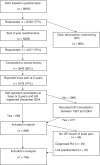Inequalities in primary care management of knee pain and disability in older adults: an observational cohort study
- PMID: 21733968
- PMCID: PMC3176713
- DOI: 10.1093/rheumatology/ker179
Inequalities in primary care management of knee pain and disability in older adults: an observational cohort study
Abstract
Objectives: To describe primary care management of knee pain, in relation to National Institute for Health and Clinical Excellence (NICE) OA guidelines, and examine variation in management by patient characteristics.
Methods: Subjects were 755 adults aged ≥50 years who responded to baseline and 3-year surveys and had consulted primary care for knee pain. Medical records (1997-2006) were searched. Associations of having interventions from the outer circle (adjunctive treatments or Step 3) of the NICE guidelines with self-reported socio-demographic and knee-specific factors were determined.
Results: Eighty per cent had received a Step 3 intervention. Thirty-eight per cent had been referred to secondary care, and 10% had received a knee replacement. Forty-three per cent had been prescribed an opioid and 41% an NSAID. Severe knee pain or disability at baseline and follow-up was the main association with receiving a Step 3 intervention [adjusted odds ratio (OR) 2.26; 95% CI 1.38, 3.70] and with referral (OR 2.57; 95% CI 1.72, 3.83). Older patients were less likely to be referred. Although non-significant, those of higher social class, in more affluent areas, older age or overweight or obese, appeared more likely to receive a knee replacement. Fifty per cent of those reporting severe knee pain or disability in both surveys had not been referred to secondary care.
Conclusion: Most of the older adults who consult primary care with knee pain receive at least one Step 3 intervention from the OA guidelines. Inequalities in the management and referral of knee problems in primary care were generally not observed, although there were some trends towards differences in likelihood of total knee replacement.
Figures
Similar articles
-
The influence of consulting primary care on knee pain in older people: a prospective cohort study.Ann Rheum Dis. 2008 Dec;67(12):1702-9. doi: 10.1136/ard.2007.080259. Epub 2008 Jan 31. Ann Rheum Dis. 2008. PMID: 18245113
-
Uptake of the NICE osteoarthritis guidelines in primary care: a survey of older adults with joint pain.BMC Musculoskelet Disord. 2018 Aug 17;19(1):295. doi: 10.1186/s12891-018-2196-2. BMC Musculoskelet Disord. 2018. PMID: 30115048 Free PMC article.
-
Knee pain and osteoarthritis in the general population: what influences patients to consult?Fam Pract. 2007 Oct;24(5):443-53. doi: 10.1093/fampra/cmm036. Epub 2007 Aug 4. Fam Pract. 2007. PMID: 17675657
-
Knee pain and osteoarthritis in older adults: a review of community burden and current use of primary health care.Ann Rheum Dis. 2001 Feb;60(2):91-7. doi: 10.1136/ard.60.2.91. Ann Rheum Dis. 2001. PMID: 11156538 Free PMC article. Review.
-
Treatment of knee pain in older adults in primary care: development of an evidence-based model of care.Rheumatology (Oxford). 2007 Apr;46(4):638-48. doi: 10.1093/rheumatology/kel340. Epub 2006 Oct 24. Rheumatology (Oxford). 2007. PMID: 17062646 Review.
Cited by
-
Driving factors for the utilisation of healthcare services by people with osteoarthritis in Portugal: results from a nationwide population-based study.BMC Health Serv Res. 2021 Sep 28;21(1):1022. doi: 10.1186/s12913-021-07045-4. BMC Health Serv Res. 2021. PMID: 34583701 Free PMC article.
-
Ethnic differences in the prevalence of knee pain among adults of a community in a cross-sectional study.BMJ Open. 2016 Dec 1;6(12):e011925. doi: 10.1136/bmjopen-2016-011925. BMJ Open. 2016. PMID: 27909033 Free PMC article.
-
'...I've found once the weight had gone off, i've had a few twinges, but nothing like before'. Exploring weight and self-management of knee pain.Musculoskeletal Care. 2014 Jun;12(2):63-73. doi: 10.1002/msc.1054. Epub 2013 Jul 17. Musculoskeletal Care. 2014. PMID: 23861332 Free PMC article.
-
Cost-utility analysis of interventions to improve effectiveness of exercise therapy for adults with knee osteoarthritis: the BEEP trial.Rheumatol Adv Pract. 2018;2(2):rky018. doi: 10.1093/rap/rky018. Epub 2018 Jun 6. Rheumatol Adv Pract. 2018. PMID: 30506022 Free PMC article.
-
18F-FDG PET-CT for the prediction of mortality in patients with dermatomyositis and without malignant tumors: a pilot study.Quant Imaging Med Surg. 2023 Jun 1;13(6):3522-3535. doi: 10.21037/qims-22-1174. Epub 2023 Mar 30. Quant Imaging Med Surg. 2023. PMID: 37284117 Free PMC article.
References
-
- Busija L, Hollingsworth B, Buchbinder R, Osborne RH. Role of age, sex, and obesity in the higher prevalence of arthritis among lower socioeconomic groups: a population-based survey. Arthritis Rheum. 2007;57:553–61. - PubMed
-
- Morris S, Sutton M, Gravelle H. Inequity and inequality in the use of health care in England: an empirical investigation. Soc Sci Med. 2005;60:1251–66. - PubMed
-
- Lubar D, White PH, Callahan LF, et al. A National public health agenda for osteoarthritis. Semin Arthritis Rheum. 2010;39:323–6. - PubMed
-
- Lidgren L, Smolen J, Bentley G, et al. European action towards better musculoskeletal health. A public health strategy to reduce the burden of musculoskeletal conditions. Lund: University Hospital Lund; 2004.
-
- Department of Health. The Musculoskeletal Services Framework. A joint responsibility: doing it differently. London: Department of Health; 2006.
Publication types
MeSH terms
Grants and funding
LinkOut - more resources
Full Text Sources
Medical



